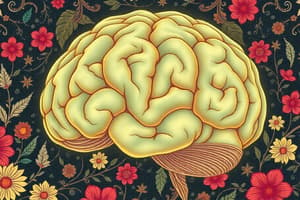Podcast
Questions and Answers
What happens to the neurons that innervate the face area after the loss of a hand?
What happens to the neurons that innervate the face area after the loss of a hand?
- They completely die off due to lack of use.
- They develop axon collaterals to the area of the missing hand. (correct)
- They become more active and take over the hand functions.
- They become less efficient and atrophy.
Which aspect signifies the concept of neuroplasticity in the brain?
Which aspect signifies the concept of neuroplasticity in the brain?
- The brain can only shrink in response to damage.
- The brain's organization remains static throughout life.
- Neurons in the brain do not adapt to new learning experiences.
- Some areas of the brain become larger while others shrink. (correct)
What role does V.S. Ramachandran play regarding the topic of phantom limbs?
What role does V.S. Ramachandran play regarding the topic of phantom limbs?
- He explains the phenomenon as a result of brain reorganization. (correct)
- He is known for studying the genetic factors affecting limb growth.
- He focuses on surgical solutions for phantom limb sensations.
- He leads experiments on visual perception exclusively.
What factors can influence neuroplasticity?
What factors can influence neuroplasticity?
How is Ramachandran described in relation to his contributions to neuroscience?
How is Ramachandran described in relation to his contributions to neuroscience?
What is neuroplasticity primarily defined as?
What is neuroplasticity primarily defined as?
What are the two main types of plasticity discussed?
What are the two main types of plasticity discussed?
How does structural plasticity primarily affect neurons?
How does structural plasticity primarily affect neurons?
What can lead to neuroplasticity?
What can lead to neuroplasticity?
Which statement about the brain's capacity for plasticity is true?
Which statement about the brain's capacity for plasticity is true?
What is a key characteristic of synaptic plasticity?
What is a key characteristic of synaptic plasticity?
In what way does aging affect neuroplasticity?
In what way does aging affect neuroplasticity?
Which factor is least likely to contribute to plasticity?
Which factor is least likely to contribute to plasticity?
What process describes the strengthening of synapses due to repeated communication between neurons?
What process describes the strengthening of synapses due to repeated communication between neurons?
What impact does an enriched environment have on rats according to the principles of neuroplasticity?
What impact does an enriched environment have on rats according to the principles of neuroplasticity?
What is the term for new branches formed by non-damaged axons to connect with vacant areas after brain damage?
What is the term for new branches formed by non-damaged axons to connect with vacant areas after brain damage?
How do exercise and physical activity influence brain plasticity?
How do exercise and physical activity influence brain plasticity?
What phenomenon occurs after a limb is amputated, leading to sensations in the missing limb?
What phenomenon occurs after a limb is amputated, leading to sensations in the missing limb?
What effect does stress have on the dendritic branching of rats?
What effect does stress have on the dendritic branching of rats?
What explains the pain associated with phantom limbs?
What explains the pain associated with phantom limbs?
What role do trophic factors play in neuroplasticity?
What role do trophic factors play in neuroplasticity?
Flashcards are hidden until you start studying
Study Notes
What is Neuroplasticity?
- The capability of the brain to adapt and change over time
- The brain is constantly changing, not a static entity
- Plasticity is a result of new experiences, memories, gradual neuronal loss, and brain damage
- Plasticity is higher early in life but is still present throughout life
Structural vs Synaptic Plasticity
- Structural plasticity: Changes in the physical properties of neurons, including the number of neurons, dendrites, axon terminals, and dendritic spines
- Synaptic plasticity: Changes in the ability of neurons to communicate with each other, altering the strength of synaptic connections.
Examples of Neuroplasticity
- Enriched environment: Rats raised in an enriched environment have a thicker cortex and increased dendritic branching
- Stressful environment: Rats raised in a stressful environment have smaller dendritic branching
- Exercise:
- Increases trophic factors that facilitate the survival of neurons
- Leads to measurable expansion of neurons
- Counteracts the decline in the thickness of the cerebral cortex in old age
Plasticity after Brain Damage
- Axon sprouting: New branches formed by non-damaged axons, creating synapses in vacant areas after brain damage
- Phantom limbs:
- Sensation of a missing limb, often accompanied by pain
- Occurs due to the brain reorganizing areas adjacent to the missing limb to innervate the vacated space
- The brain area representing the missing limb remains intact but receives no input, leading to reorganization
Neuroplasticity Summary
- The brain constantly reorganizes in response to sensory inputs, motor outputs, learning, memory, stress, exercise, etc.
- Neuroplasticity can strengthen or weaken connections, with some areas expanding and others shrinking.
Studying That Suits You
Use AI to generate personalized quizzes and flashcards to suit your learning preferences.




